These lettuce wraps with chicken are quick and easy to make. If you’re on a low carb diet, you could cook up a big batch of miso chicken on Sunday night to keep in the fridge. Reheat, wrap with lettuce leaves, and that’s it– Monday’s lunch is ready!
Jump to Recipe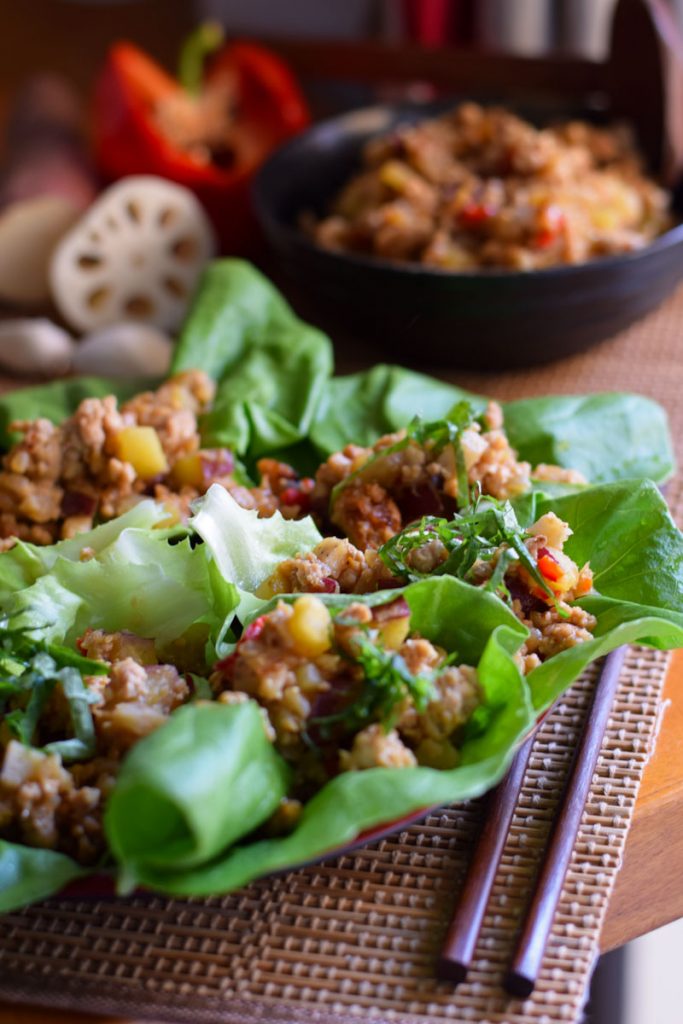
JAPANESE-STYLE LETTUCE WRAPS
In Japan and Korea, people have been eating lettuce wraps long before low carb diets became popular in the West.
My introduction to lettuce wraps must have been at Tonchang, a Korean barbecue restaurant in Shin-Ookubo, Tokyo’s Koreatown.
Thick strips of fatty pork belly, called samgyeopsal, are grilled right in front of you at your table.
After the long strips are cut into bite-sized pieces with kitchen scissors, you wrap the pork inside a big, fresh leave of lettuce. Add in kimchi, slices of garlic, and maybe some spicy chili miso sauce. Then, using your hands, you can dip it in sesame oil with black pepper.
I first discovered the Japanese version of wraps at a “secret restaurant” tucked around the corner of a secluded side street in my old neighborhood, Omotesando. I took my girlfriend there on a dinner date specifically to eat the miso pork cabbage wraps with saké.
If this is all new to you, boy, are you in for a treat…
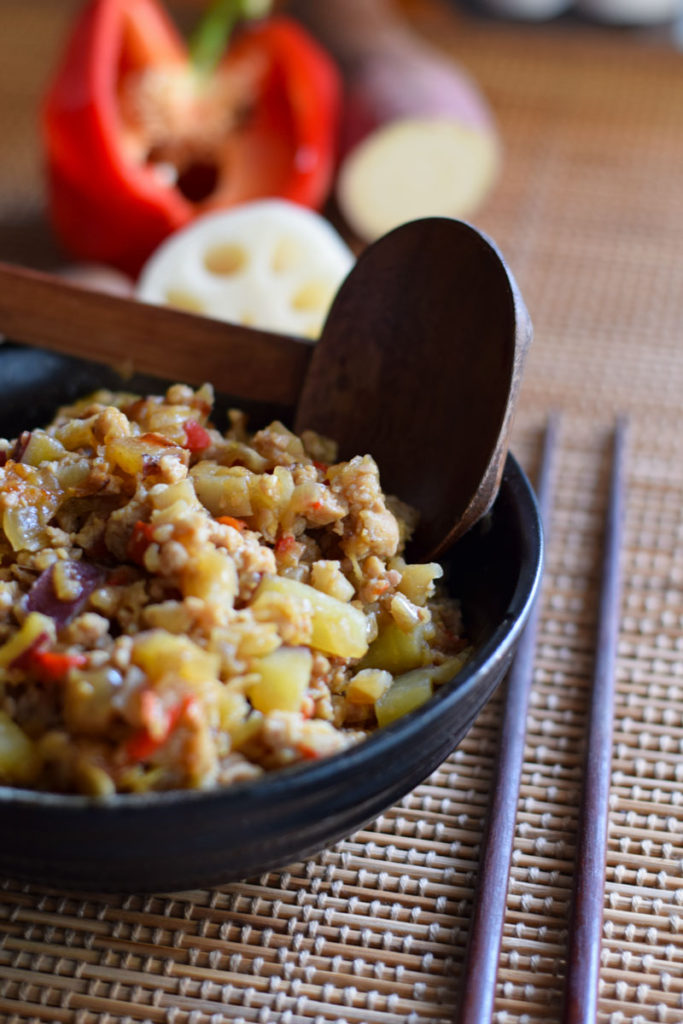
MISO-FLAVORED MINCED CHICKEN
The meat in these lettuce wraps is called nikumiso in Japanese. For the Japanese classic way of making nikumiso, minced pork is more commonly used. I switched to chicken because I’m trying to limit the number of meals I eat with red meat (climate change).
I won’t lie, the original pork version is just as good if not better. I’ll still eat it on occasion.
This is a great recipe to try with leftover ground chicken, pork, or even turkey after Thanksgiving.
It’s what you’ll want the day after Thanksgiving:
a light meal that’s simple to prepare and won’t make a big mess in the kitchen.
Instead of making turkey sandwiches, why not try out some Japanese finger food?
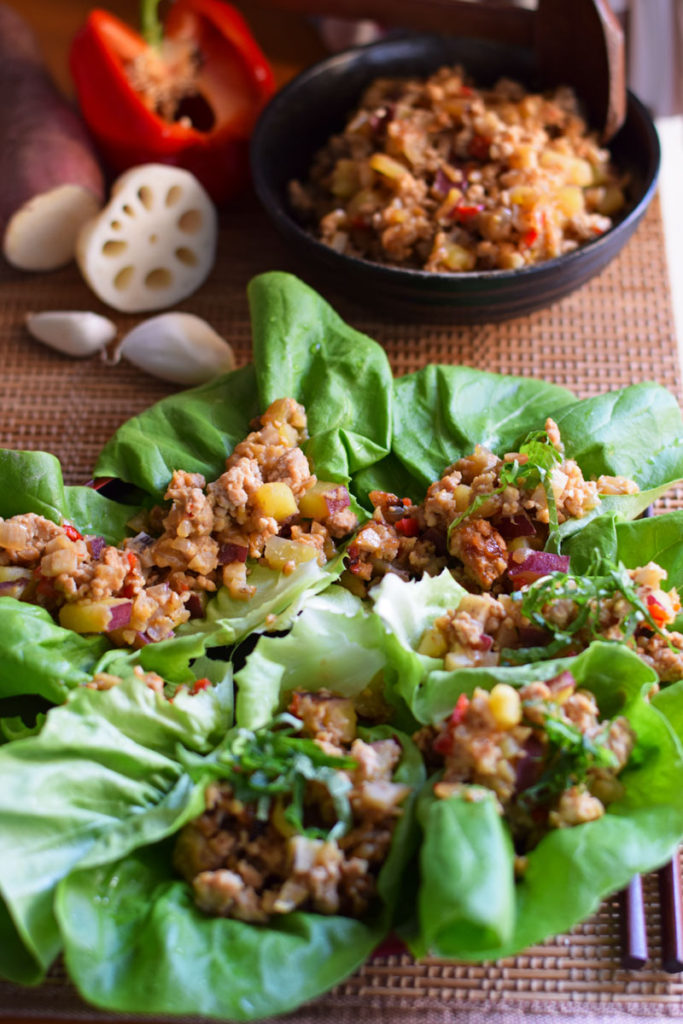
The ABCs of Japanese Cooking
Traditional recipes for nikumiso usually call for a combination of saké, sugar, and/or mirin, which also adds sweetness.
In Japanese, there’s a mnemonic to remember the order of adding seasonings:
sa-shi-su-se-so
Sa is for satou, sugar. Shi for shio, salt. Su is vinegar. Se for shoyu, soy sauce (spelled seuyu in old Japanese). And so is the so in miso.
In home kitchens and restaurants in Tokyo, sugar or mirin is usually added when making any typical Japanese dish or sauces like teriyaki.
Cuisine in Kyoto is known for lighter, more subtle flavors. They tend to avoid adding sugar.
In my Tokyo kitchen, I leave out the sugar and mirin for health’s sake, without sacrificing too much taste.
During the work week, I tend not add saké as well, so not to be tempted to drink what’s leftover after the one splash that goes into the fry pan.
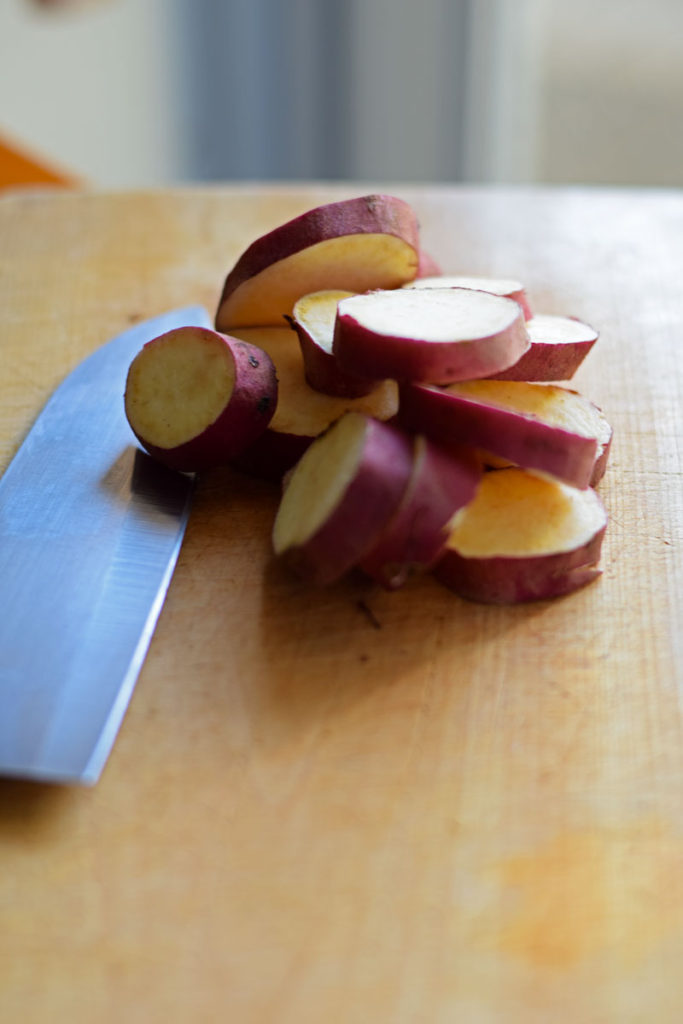
Cooking with Japanese Ingredients
The first time I tried making this recipe, I added too much miso. While I thought that I was erring on the side of adding too little, I was wrong.
When I tasted the meat, it was already too salty, which meant that I didn’t want to add any soy sauce.
Luckily, I forgot to add soy sauce before the miso: sa-shi-su-se-so
I also wanted to experiment with leaving out the saké to cut out sugar and carbs. Just like cooking with wine, the saké will open up the flavors. I wanted to taste the difference firsthand if I left out the saké.
For a first attempt, it wasn’t bad.
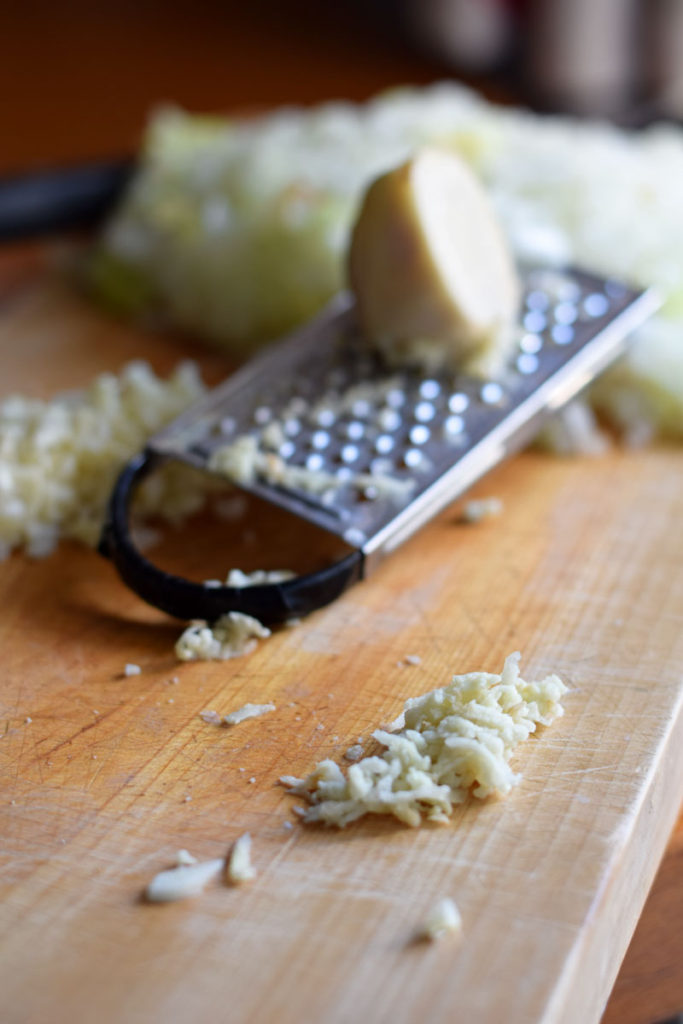
“The Golden Ratio” of Japanese Cuisine
On my second try, I cut the amount of miso and added soy sauce and one clove of garlic. It’s such a simple dish, but these small adjustments made all the difference. It turned my miso chicken from “it’s too salty but ok” into “wow, that’s really good.”
Japanese cooking uses a simple mixture of basic ingredients in the right proportions. Many of the Japanese dishes, soups, and sauces that you love contain the same combination of ingredients: dashi broth, soy sauce, and mirin.
The secret is getting the ratio just right.
In Japanese, they say aji no ogonhi, “the Golden Ratio” of Japanese cooking.
If you’re a newbie to cooking with Japanese ingredients, I recommend that you measure out your seasonings carefully to achieve that perfect balance. Once you hit that just-right combination of flavor, with practice you’ll be able to use the golden ratio intuitively like a real Japanese chef.
To be honest, I’m not there yet. Remember, I’m from Wisconsin, the “Cheese State”. We’re learning this together!
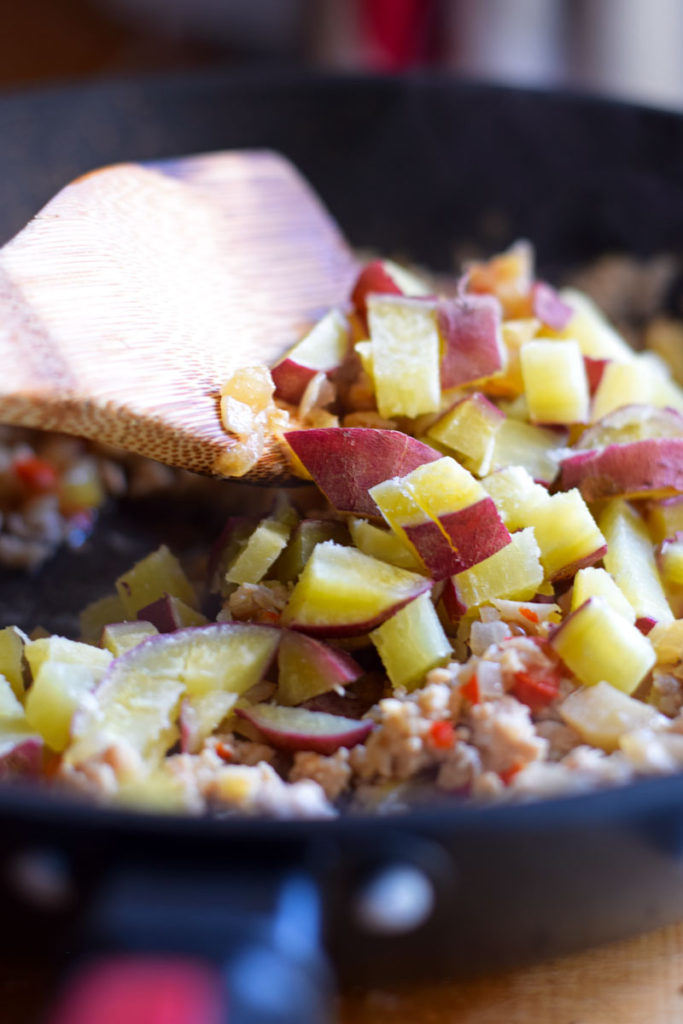
INGREDIENTS
- ¾ lbs minced chicken
- ¾ cup Japanese sweet potato cubed
- 1 onion medium size
- ½ cup lotus root (renkon) cubed
- ⅓ red pepper finely chopped
- 1 knob fresh ginger root grated
- 2 garlic cloves finely chopped
- 2 ½ tsp sesame oil
- 1 tsp soy sauce or gluten-free alternative
- 2 tsp miso paste
- ½ cup water
- 2 tbsp sake (optional)
- fresh lettuce leaves
- perilla leaves (shiso) thinly sliced to garnish
Dipping Sauce (one serving)
- 3-4 teaspoon vinegar
- freshly ground black pepper
KITCHEN TOOLS NEEDED
- large frying pan / large skillet
- spatula
- one medium/ large-sized bowl and one small bowl
- knife
- cutting board
- vegetable peeler
- grater
Where to Buy Miso and Your Health
If you are new to cooking with miso, I recommend buying the smallest tub you can find.
I found a small tub of organic Hikari brand miso at a Natural Lawson’s convenience store in Tokyo. Knowing that if I bought the regular family-size miso, it would sit in my refrigerator until months past the expiration date.
Unless you make miso soup every day for a Japanese family of five, you might want to do the same.
Even if you don’t live in Japan, you should be able to find miso at your local Japanese or Asian grocery store.
I also just checked on amazon.com… I found organic Hikari red miso. Red miso is saltier than white or awase (mixed) miso so you’ll want to be careful to not add too much.
Especially for those of you who have a gluten intolerance, it’s also important to note that some varieties of miso are made with wheat, barley, and rye.
Earlier today I read a headline that said “miso is 2019’s new superfood”.
Despite its high salt content, miso is really nutritious. Made from fermented soybeans and grains, it contains millions of beneficial bacteria for your gut.
And it adds a wonderful, rich flavor to food. Miso a key ingredient in so many Japanese recipes that I know you’d love.
Just trust me on this one: buy the small size.
How to make Japanese Lettuce Wraps with Chicken – Miso
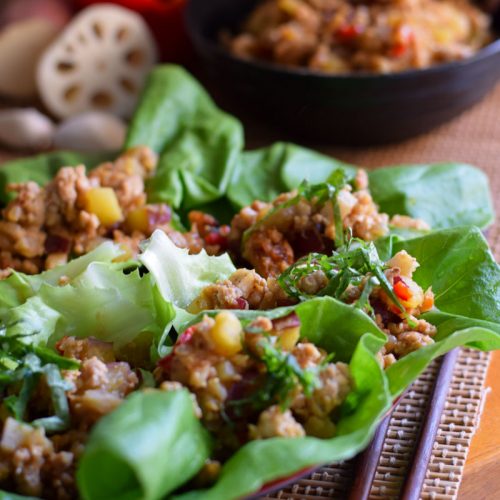
Lettuce Wraps with Chicken (Miso-Flavored)
Ingredients
- ¾ cup Japanese sweet potato cubed
- 1 onion medium size
- ½ cup lotus root (renkon) cubed
- ⅓ red pepper finely chopped
- 1 knob fresh ginger grated
- 2 cloves garlic finely chopped
- 2 ½ teaspoon sesame oil
- 1 teaspoon soy sauce or gluten-free alternative
- 2 teaspoon miso
- ½ cup water
- 2 tablespoon sake optional
- fresh lettuce leaves
- perilla leaves (shiso) thinly sliced to garnish
Instructions
Prep (Sweet Potato)
- Cut Japanese sweet potato into approximately ¾ inch (2 cm) slices.

- Fill small sauce pan halfway with water and add slices of sweet potato. Turn stove on high; bring water to a boil.
- Reduce heat if water begins to boil over.
- After 4-5 minutes, poke sweet potato slices with fork.
- Once fork pokes through the sweet potato easily, remove from water with a strainer. Set aside.
- Later, when sweet potato has cooled, cut into small cubes.
Prep (Vegetables and Minced Chicken)
- Remove peel and chop onion (see size in photo) and finely chop garlic.

- Peel and finely grate ginger.

- Peel and chop lotus root into 1 cm wide slices and then into small cubes.

- Finely chop red pepper.
- Thinly slice perilla (shiso) leaves to garnish.
- Spoon miso into a small dish and mix with water.
Cooking
- Turn stove on. Add sesame oil to pan on low heat.
- Add chopped onion to fry pan. Stir occasionally.
- Once the onion begins to soften, add finely chopped garlic to the fry pan.
- Once garlic begins to turn golden brown (1- 2 minutes), add chopped lotus root and finely chopped red pepper.
- Once all the added vegetables have softened (another 1 - 2 minutes), add finely grated ginger and minced chicken.
- Continue to cook on low heat, stirring occasionally, until the chicken is fully cooked.
- Finally, add the cubes of sweet potato and stir.

- Add soy sauce (or gluten-free alternative) to the fry pan. Stir.
- And then add the mix of miso and water. Stir in.
- Add sake (optional). Stir.
- Continue to cook. Once most of the liquid has boiled off, turn off heat.
- Serve in a bowl (or directly onto the lettuce).

Garnish and Dipping Sauce (Optional)
- Scoop nikumiso on top of each lettuce leaf.

- Garnish with sliced perilla (shiso).

- Mix rice wine vinegar and freshly ground black pepper to make a dipping sauce.

Notes
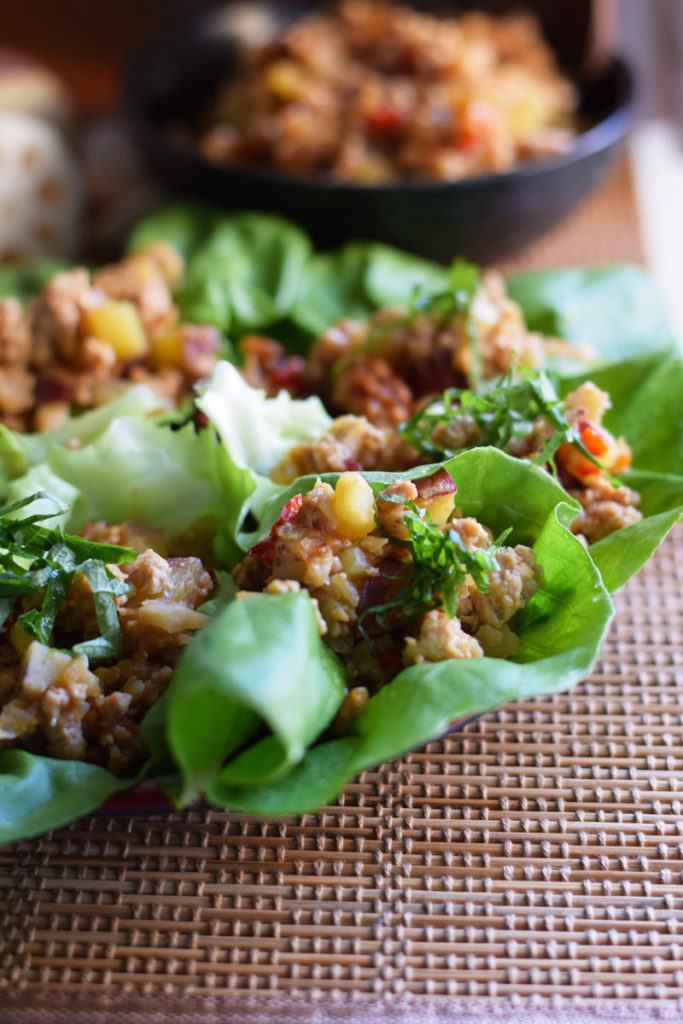
FREQUENTLY ASKED QUESTIONS
1) Which lettuce is best for wraps?
The best kind of lettuce to use has leaves that are large, tender, and easy to fold like butter lettuce, romaine lettuce, red leaf or green leaf lettuce. Crunchier varieties like iceberg lettuce isn't ideal. Iceberg lettuce also has the lowest nutritional value.
You can also add another layer of leafy green on top of your lettuce leaf. Perilla (shiso) leaves are added to Korean lettuce wraps called samgyupsal. Like Korean bbq, you could use just larger shiso leaves to make smaller size wraps. Little gem lettuce is another option for making mini-sized wraps. That might be the perfect size for a one-bite finger food appetizer or for kids.
Baby leaves that come in bags of mixed greens would most likely be too small.
The best lettuce wraps are when you have a variety of lettuce or leafy greens to try. If you have a really good farmers market nearby, you probably can find a good bouquet of options.
If a lettuce cup is what you were thinking, here is information for choosing the right lettuce.
2) Are lettuce wraps good for losing weight?
Yes, lettuce wraps are an easy recipe for trimming your waistline. Really before I make any claim like that, I have to say that it depends on what you put on the inside. If your lettuce wrap fillings are batter fried, high in carbs, or smothered in sugary sauces or creamy dressing, then no they aren't.
I find that lettuce wraps fill me up. It's a great meal to have on a regular basis if you're trying to cut out carbs like bread, rice, or pasta. If you're eating lettuce wraps like my miso chicken recipe, you should be able to lose weight. If you start going to the gym, remember that weight gain isn't all bad, if it's more muscle.
If you're really serious about getting trimmed down, you may want to not add any carbs on the inside of lettuce wraps. For example, in my recipe you can leave out the lotus root and sweet potato or add smaller amounts.
Also, if you know that you'll eventually get bored of eating salads all the time, eating a lettuce wrap adds some variety. It feels like a different experience than eating your same old salad.
3) Are lettuce wraps healthier than bread?
Yes, lettuce wraps are a healthy alternative dinner to sandwiches made with bread or buns. Most bread is high in carbs. Even if you eat whole wheat, your body breaks down the carbs into glucose (sugar). And your body will turn excess glucose into fat for storage.
Bread made with wheat flour contains gluten. Even if you aren't gluten intolerant, you may still want to consider cutting out or eating less bread. According to Dr. Mark Hyman, "Gluten has been found to negatively impact the lining of the gut, creating “leaky gut” or intestinal permeability, even in those who do not have celiac disease." (drhyman.com)
Lettuce is also a good source of vitamins and minerals, especially vitamin A and K, and antioxidants. Just 100 grams of fresh, raw lettuce provides 247% daily values of vitamin-A, and 4,443 µg of β-carotene (Carotenes convert into vitamin-A in the body; 2 µg of carotene is considered equivalent to 1 IU of vitamin-A). These compounds possess strong antioxidant properties (nutrition and you).
Water makes up over 95% of raw lettuce. As a result, eating also lettuce hydrates the body. (WebMD)
Basically, a lettuce wrap is like eating a salad that you can pick up with your hands.
4) What is PF Chang's lettuce wraps made of?
P.F. Chang asian chicken lettuce wraps
Olive oil
Sesame oil
Ground chicken (or chicken breasts finely chopped will work)
Yellow onion
Hoisin sauce
Soy sauce
Rice wine vinegar (rice vinegar)
Garlic
Ground ginger
Green onions
Chili garlic sauce
Water chestnuts
Lettuce
Author’s note:
This was my first recipe from kitchen in Tokyo!
Yesterday afternoon, I cooked and took pictures for two hours straight. If it weren’t for losing sunlight, I would have completely lost track of time. I didn’t eat “lunch” until after 4:30, which was the first time I paused to look up at the clock.
It feels so good to be back at it!
In the beginning, this recipe wasn’t great. Once again, I was reminded to have patience and faith things will work out.
In the end, after a week of tweaking, these lettuce wraps turned out even better than I expected.
Thank you for reading! I hope you love this recipe–
Matt


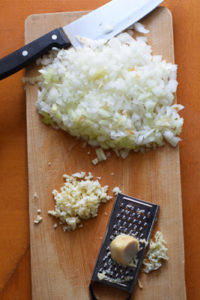
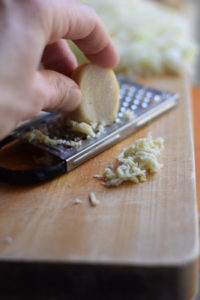
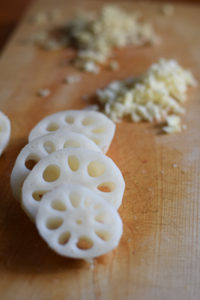
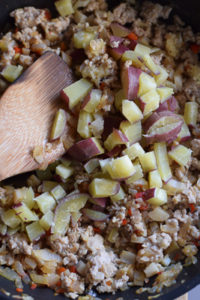
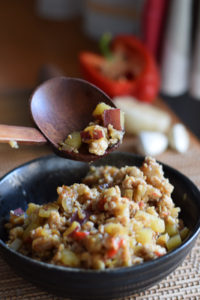
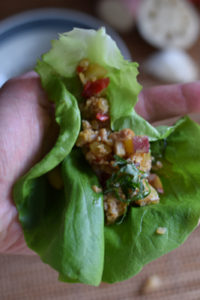
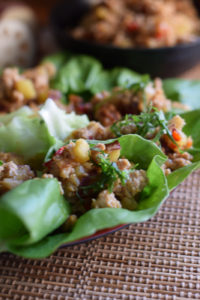
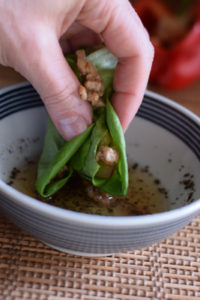





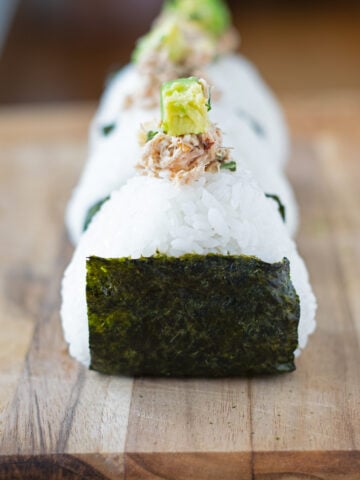

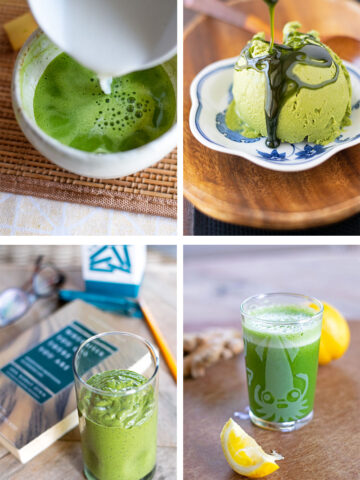
Leave a Reply